Antenna Calculator
for HF Antennas
Here is a simple antenna calculator for two popular forms of ham radio HF wire antennas: the horizontal dipole and the inverted "V".
(Updated June 5, 2021)
The Antenna Calculator
for
Half-Wave Dipoles
Enter your desired frequency (MHz) of operation (i.e. 3.55). If you have no particular preference within a given ham radio band, then simply enter its center frequency (i.e. 7.15 for the 40 meter band).
To fully understand the results obtained by this calculator, please take a few minutes to read the explanation below it.
Interpreting The Results
Here is how to interpret the resulting wire lengths given by the calculator.
Be prepared to trim the ends of the inverted V dipole if the final frequency of resonance ends up being too low for your needs when the inverted V is installed in its permanent position.
The Half-Wave Dipole Antenna
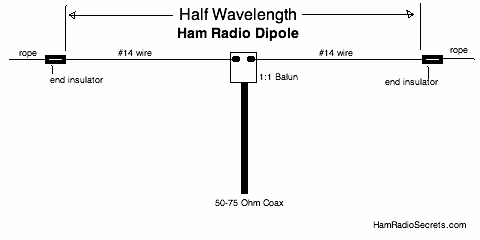
The most widely used formula to calculate the approximate overall length of wire required for a dipole is:
468 / frequency (MHz) = length of wire in feet.
The antenna calculator above uses this formula as a starting point to calculate wire lengths for the dipole. The results are conveniently displayed in inches, centimeters, feet and meters.
This formula to obtain the length of a half-wave dipole antenna will give a good ballpark value to start with.
However, the actual resulting frequency of resonance and feed-point impedance of a dipole will depend on:
- The height of the dipole above ground;
- The conductivity of the ground below;
- The dielectric constant of the ground below;
- The presence of buildings, trees, metal structures (tower) nearby.
The Inverted V Dipole Antenna
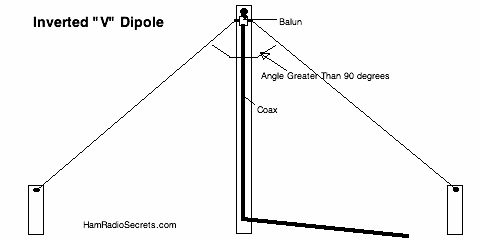
When each side of a dipole slopes down from the feed point, it is commonly called an inverted V.
The inverted V results in:
- A more omni-directional radiation pattern than that of a dipole.
- A lower resonant frequency for the same length of wire as the dipole.
- A lower feed point impedance than the horizontal dipole (for feed points at the same height above ground).
- Some loss in bandwidth.
Some say that the inverted V
should be cut 5% shorter than the dipole. I chose to make it about 4% shorter.
The antenna calculator above will give you a wire length for the inverted 'V' which will be about 4% shorter than that of a dipole at the same desired frequency of operation. This will give you some leeway to trim the wire ends back if the inverted V resonates too low for your purpose when installed in its final position.
The formula used by the calculator to compute the wire lengths for the inverted V is based on the formula for a half-wave dipole. It is adjusted to take into account the special characteristics of the inverted V.
In the case of the inverted V we must add - to the list of environmental variables influencing the half-wave dipole - the angle between the two legs of the inverted V.
The angle below the two sections of a horizontal dipole is 180 degrees. As the two sections of the dipole are lowered below the feed point, the angle between the two legs decreases:
- The resonant frequency of the inverted V is lowered (see the theory behind this at the bottom of this page).
- The influence of the ground conductivity and dielectric constant becomes an increasing factor.
NOTE: if you start by giving the calculator your *desired* frequency of operation, the inverted V - when installed in its final position - may be still end up too short or too long, depending on the environmental conditions mentioned above.
- If the antenna is too long (resonates below your desired frequency) then it's not a problem: you just trim each leg a little at a time until you reach lowest SWR.
Note: To avoid cutting the wire, I usually just fold back each end of the antenna wire on itself and tape it tight if it's insulated wire - or twist it back on itself if you are using bare wire. - But if the antenna is too short (resonates above your desired frequency) then it's a little more trouble to add wire to each leg to bring down its frequency of resonance where you want it.
To avoid the latter outcome, the antenna calculator above is set up to compensate somewhat for local adverse environmental conditions. The length it will calculate will likely be a little too long. You will only have to trim it a few inches at a time to bring the frequency of resonance up to where you want it.
For more detailed information on ham radio HF wire antennas, please visit this section of our Web site.
Furthermore...
If the angle between the two legs of the inverted V becomes less than 90 degrees, the radiation patterns from each leg of the inverted V begin to interact and cancel each other to some extent.
Therefore, the angle between the two legs of an inverted V should not be less than 90 degrees.
Remember, an inverted V requires slightly less wire than a horizontal dipole for a given frequency of resonance.
The Theory Behind The Antenna Calculator
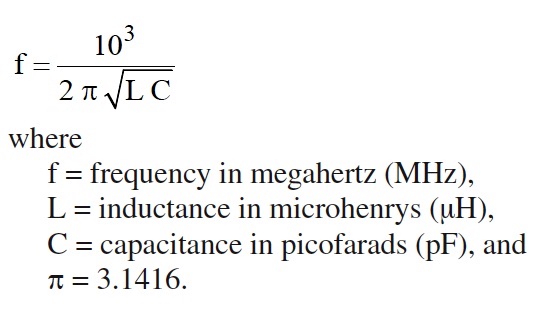 Resonant frequency formula
Resonant frequency formulaA dipole antenna is a resonant circuit at a given frequency. The same goes for an inverted 'V' version of that dipole.
However, when we lower each leg of a dipole antenna closer to the ground, we
introduce additional capacitance - which arises from the closer proximity of the antenna legs to the ground.
Consequently, for a given frequency of resonance, the legs of an inverted 'V' must be made slightly shorter - by about 2% each (overall length of wire about 4% shorter) - than a horizontal dipole.
The formula proves it!
When capacitance (C) is increased, the inductance (L) must be decreased if we are to arrive at the same frequency of resonance as before.
If you don't want to bother doing calculations with the formula, the antenna calculator above will provide appropriate wire lengths, to start with, for the inverted V and the dipole at a given frequency of your choice.
73 de VE2DPE
Claude Jollet
104-30 avenue des Berges,
Notre-Dame-des-Prairies, Québec, Canada J6E 1M9
QTH Locator: FN36gb
Disclosure
If
you make a purchase via a link on this site, I may receive a small
commission on the transaction, at no extra cost to you. Thank you!
(One word queries work best)
HF Antennas
Section
Contents
VHF/UHF Antennas
FOUND THIS
SITE
USEFUL?
VE2DPE
Is a member
in good standing
of
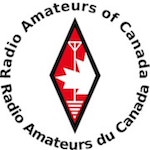

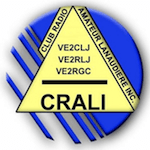
Also a proud member of an international community of solopreneurs
using SoloBuildIt!
(SBI!)
to promote my self-published eBooks
since 2005.
See my review
of this unique product for online businesses.
CQ CQ CQ
If you have a question, a comment or a topic you would like me to cover, please do not hesitate to ask here.


